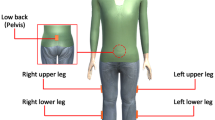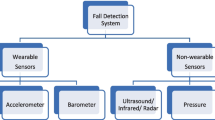Abstract
Falls are the leading cause of injury-related morbidity and mortality among older adults. Over 90 % of hip and wrist fractures and 60 % of traumatic brain injuries in older adults are due to falls. Another serious consequence of falls among older adults is the ‘long lie’ experienced by individuals who are unable to get up and remain on the ground for an extended period of time after a fall. Considerable research has been conducted over the past decade on the design of wearable sensor systems that can automatically detect falls and send an alert to care providers to reduce the frequency and severity of long lies. While most systems described to date incorporate threshold-based algorithms, machine learning algorithms may offer increased accuracy in detecting falls. In the current study, we compared the accuracy of these two approaches in detecting falls by conducting a comprehensive set of falling experiments with 10 young participants. Participants wore waist-mounted tri-axial accelerometers and simulated the most common causes of falls observed in older adults, along with near-falls and activities of daily living. The overall performance of five machine learning algorithms was greater than the performance of five threshold-based algorithms described in the literature, with support vector machines providing the highest combination of sensitivity and specificity.




Similar content being viewed by others
References
Albert MV, Kording K, Herrmann M, Jayaraman A (2012) Fall classification by machine learning using mobile phones. PLoS One 7(5):e36556
Arnold CM, Faulkner RA (2007) The history of falls and the association of the timed up and go test to falls and near-falls in older adults with hip osteoarthritis. BMC Geriatr 7:17
Aziz O, Park EJ, Mori G, Robinovitch SN (2012) Distinguishing near-falls from daily activities with wearable accelerometers and gyroscopes using support vector machines. In: Conference proceedings of IEEE engineering in medicine biology society 2012, pp 5837–5840
Aziz O, Park EJ, Mori G, Robinovitch SN (2014) Distinguishing the causes of falls in humans using an array of wearable tri-axial accelerometers. Gait Posture 39(1):506–512
Aziz O, Robinovitch SN (2011) An analysis of the accuracy of wearable sensors for classifying the causes of falls in humans. IEEE Trans Neural Syst Rehabil Eng 19(6):670–676
Bagala F, Becker C, Cappello A, Chiari L, Aminian K, Hausdorff JM, Zijlstra W, Klenk J (2012) Evaluation of accelerometer-based fall detection algorithms on real-world falls. PLoS One 7(5):e37062
Bourke AK, O'Brien JV, Lyons GM (2007) Evaluation of a threshold-based tri-axial accelerometer fall detection algorithm. Gait Posture 26(2):194–199
Bourke AK, O'Donovan KJ, Olaighin G (2008) The identification of vertical velocity profiles using an inertial sensor to investigate pre-impact detection of falls. Med Eng Phys 30(7):937–946
Bourke AK, Scanaill CN, Culhane KM, Brien JVO, Lyons GM (2006) An optimum accelerometer configuration and simple algorithm for accurately detecting falls. In: Proceedings of the 24th IASTED international conference on Biomedical engineering. ACTA Press, Innsbruck
Bourke AK, van de Ven P, Gamble M, O'Connor R, Murphy K, Bogan E, McQuade E, Finucane P, Olaighin G, Nelson J (2010) Evaluation of waist-mounted tri-axial accelerometer based fall-detection algorithms during scripted and continuous unscripted activities. J Biomech 43(15):3051–3057
Bourke AK, van de Ven PW, Chaya AE, GM OL, Nelson J (2008) Testing of a long-term fall detection system incorporated into a custom vest for the elderly. In: Conference Proceedings of IEEE engineering in medicine and biology society 2008, pp 2844–2847
Boyle J, Karunanithi M (2008) Simulated fall detection via accelerometers. In: Conference Proceedings of IEEE engineering in medicine and biology society 2008, pp 1274–1277
Chao PK, Chan HL, Tang FT, Chen YC, Wong MK (2009) A comparison of automatic fall detection by the cross-product and magnitude of tri-axial acceleration. Physiol Meas 30(10):1027–1037
Chen J, Kwong K, Chang D, Luk J, Bajcsy R (2005) Wearable sensors for reliable fall detection. In: Conference proceedings of IEEE engineering in medicine and biology society 4, pp 3551–3554
Diaz A, Prado M, Roa LM, Reina-Tosina J, Sanchez G (2004) Preliminary evaluation of a full-time falling monitor for the elderly. In: Conference proceedings of IEEE engineering in medicine and biology society 3, pp 2180–2183
Herman M, Gallagher E, Scott VJ (2006) The evolution of seniors falls prevention in British Columbia. BC Ministry of Health Services, Victoria
Kangas M, Konttila A, Lindgren P, Winblad I, Jamsa T (2008) Comparison of low-complexity fall detection algorithms for body attached accelerometers. Gait Posture 28(2):285–291
Kau LJ, Chen CS (2015) A smart phone-based pocket fall accident detection, positioning, and rescue system. IEEE J Biomed Health Inform 19(1):44–56
Kern N, Schiele B, Schmidt A (2007) Recognizing context for annotating a live life recording. Personal Ubiquitous Comput. 11(4):251–263
King MB, Tinetti ME (1995) Falls in community-dwelling older persons. J Am Geriatr Soc 43(10):1146–1154
Lee JK, Robinovitch SN, Park EJ (2015) Inertial sensing-based pre-impact detection of falls involving near-fall scenarios. IEEE Trans Neural Syst Rehabil Eng 23(2):258–266
Lindemann U, Hock A, Stuber M, Keck W, Becker C (2005) Evaluation of a fall detector based on accelerometers: a pilot study. Med Biol Eng Comput 43(5):548–551
Mallinson WJ, Green MF (1985) Covert muscle injury in aged patients admitted to hospital following falls. Age Ageing 14(3):174–178
Nevitt MC, Cummings SR, Kidd S, Black D (1989) Risk factors for recurrent nonsyncopal falls. A prospective study. JAMA 261(18):2663–2668
Noury N, Galay A, Pasquier J, Ballussaud M (2008) Preliminary investigation into the use of autonomous fall detectors. In: Conference proceedings of IEEE engineering in medicine and biology society 2008, pp 2828–2831
Noury N, Rumeau P, Bourke AK, ÓLaighin G, Lundy JE (2008) A proposal for the classification and evaluation of fall detectors. IRBM 29(6):340–349
Robinovitch SN, Feldman F, Yang Y, Schonnop R, Leung PM, Sarraf T, Sims-Gould J, Loughin M (2013) Video capture of the circumstances of falls in elderly people residing in long-term care: an observational study. Lancet 381(9860):47–54
Srygley JM, Herman T, Giladi N, Hausdorff JM (2009) Self-report of missteps in older adults: a valid proxy of fall risk? Arch Phys Med Rehabil 90(5):786–792
Tinetti ME, Williams CS (1998) The effect of falls and fall injuries on functioning in community-dwelling older persons. J Gerontol A Biol Sci Med Sci 53(2):M112–M119
Vellas B, Cayla F, Bocquet H, de Pemille F, Albarede JL (1987) Prospective study of restriction of activity in old people after falls. Age Ageing 16(3):189–193
Weiss A, Shimkin I, Giladi N, Hausdorff JM (2010) Automated detection of near falls: algorithm development and preliminary results. BMC Res Notes 3:62
Weiss GM, Provost F (2003) Learning when training data are costly: the effect of class distribution on tree induction. J Artif Intell Res 19(1):315–354
Wild D, Nayak US, Isaacs B (1981) How dangerous are falls in old people at home? Br Med J (Clin Res Ed) 282(6260):266–268
Acknowledgments
This work was supported by team grants from the Canadian Institutes of Health Research (Funding Reference Numbers: AMG-100487 and TIR-103945). SNR was also supported by the Canada Research Chairs program. The funding agency had no direct role in the design and conduct of the study; the collection, management, analysis, and interpretation of the data; or the preparation, review, or approval of the manuscript.
Author information
Authors and Affiliations
Corresponding author
Rights and permissions
About this article
Cite this article
Aziz, O., Musngi, M., Park, E.J. et al. A comparison of accuracy of fall detection algorithms (threshold-based vs. machine learning) using waist-mounted tri-axial accelerometer signals from a comprehensive set of falls and non-fall trials. Med Biol Eng Comput 55, 45–55 (2017). https://doi.org/10.1007/s11517-016-1504-y
Received:
Accepted:
Published:
Issue Date:
DOI: https://doi.org/10.1007/s11517-016-1504-y




